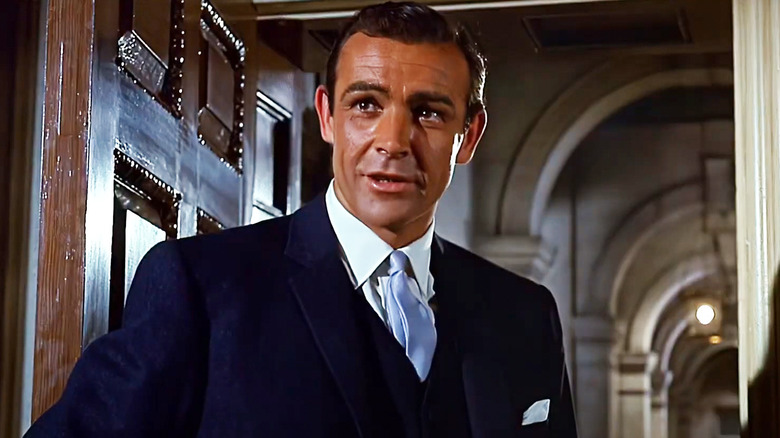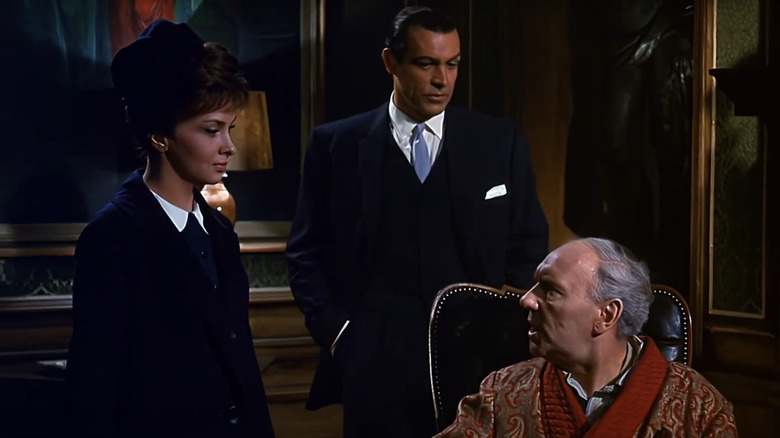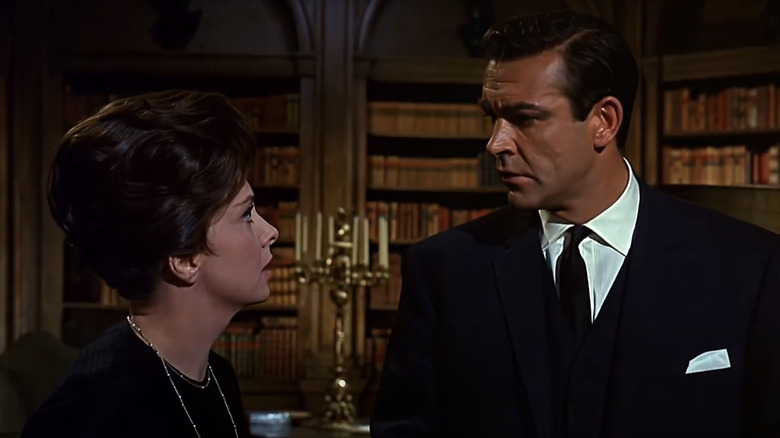Sean Connery Felt Responsible For This Crime Thriller's Failures
We may receive a commission on purchases made from links.
In 1964, Sean Connery was two years removed from his breakout turn as James Bond in "Dr. No," which kicked off cinema's most enduring franchise. Having gone from a relative unknown to a global star, the Scottish actor was about to deliver what would be remembered as one of the best James Bond films ever made with "Goldfinger," which debuted in September of '64. But before that legendary triumph arrived, Connery fronted a crime drama that was anything but legendary — at least according to critics at the time, who gave 1964's "Woman of Straw" a thorough drubbing. Soon after its release, Connery would take responsibility for the movie's failure, but he might have been a tad hard on himself.
The film was directed by Basil Dearden, who four years prior had directed the highly successful "The League of Gentlemen," one of the best heist movies of all time. "Woman of Straw" was one of two films Dearden made for United Artists with his longtime producing partner Michael Relph, but it failed to match the success of the duo's 1960 heist movie.
"Woman of Straw" stars Connery as Anthony Richmond, the nephew of millionaire Charles Richmond (Ralph Richardson) who's about to peg out and is intent upon leaving his fortune to charity. Anthony, however, has other plans. He hires Italian nurse Maria Marcello (Gina Lollobrigida) and convinces her to marry Charles in order to inherit his wealth when he dies. The idea is that Anthony will keep the majority, but Maria will get $1 million for her troubles. Of course, things don't go to plan, with Anthony double-crossing Maria by poisoning Charles before trying to frame the nurse for the crime. The melodramatic thriller failed to connect with critics, and Connery evidently saw that disappointment coming, telling Playboy (via The James Bond Dossier) in 1965, "When 'Woman of Straw' was shot down, I wasn't entirely surprised." Why? Well, according to the actor, it was all his fault.
Sean Connery blames his schedule and failed rewrites for Woman of Straw
"Woman of Straw" seemed as if it might help Sean Connery prove he was more than James Bond — something which was of the utmost importance to the actor during the early years of his 007 fame. Bond turned out to be a double-edged sword for Connery, but "Woman of Straw" saw him playing a dastardly and scheming villain, which might have seemed like just what the actor needed to subvert the public's view of him as England's greatest spy. Unfortunately, Basil Dearden's thriller, which had been adapted from the French novel "La Femme de paille" by Catherine Arley, was seen as a step backwards by most of the big reviewers, who viewed it as outdated.
While the trade press critics were impressed, most of the reviewers for the newspapers and film journals were not. The New York Times' Eugene Archer, for instance, wrote, "What could be more archaic than the sight of James Bond himself, Sean Connery, stalking glumly through the very type of old-fashioned thriller he usually mocks?" According to Archer, who attended the film's premiere at the Criterion Theatre, Connery "did not look one bit more unhappy" during the event, suggesting the actor knew immediately that he'd fronted a dud — though the often austere Scott looked a bit upset quite a lot of the time anyway.
Still, we know that Connery was fully aware of the film's shortcomings based on his 1965 Playboy interview in which the star said, "I wasn't all that thrilled with 'Woman of Straw,' although the problems were my own. I'd been working nonstop for goodness knows how long and trying to suggest rewrites for it while making another film, which is always deadly. It was an experience: but I won't make that mistake again."
Sean Connery isn't entirely to blame for Woman of Straw
Shortly after "Woman of Straw" made its underwhelming debut, Sean Connery starred in a similar but much more fondly-remembered thriller with Alfred Hitchcock's "Marnie." Similarly adapted from a novel (this time Winston Graham's 1961 book of the same name), the movie wasn't all that well received upon its release (Connery's friend at The New York Times, Eugene Archer was similarly dismissive of "Marnie" as he was of "Woman of Straw"). But "Marnie" went on to enjoy a reassessment in the following decades, and is viewed as a Hitchcock classic today.
"Woman of Straw," however, hasn't received quite the same reappraisal, though it's not remembered as quite the blunder Archer and his fellow critics claimed it to be. That said, even Connery could tell the difference between his two 1964 thrillers just a year after their release. In his Playboy interview, the actor was asked if he was happy with the non-Bond films he'd made in recent years, and responded that he was happy with "Marnie," but "with certain reservations." He felt differently about "Woman of Straw," and blamed himself for the film's failure — though he should have given himself a break.
In the book "The Cinema of Basil Dearden and Michael Relph," authors Alan Burton and Tim O'Sullivan note that there had been reports of "a difficult shoot," on Basil Dearden's film, with Gina Lollobrigida reportedly being "demanding and temperamental" and clashing with both Dearden and Connery. Alongside his own hectic schedule, then, Connery looks to have been dealing with a less than ideal atmosphere on-set. What's more, the film was always going to draw comparisons to Hitchcock thrillers, and the critics were quick to do so. According to the Monthly Film Bulletin's review, the picture would have benefitted from "a touch of Hitchcock to sharpen suspense and turn the howl of a dog into something inhuman instead of noises off." With critics seemingly ready to dismiss Dearden's movie as a pale Hitchcock imitation from the outset, and reports of a contentious filming experience, Connery might not have been to blame.


